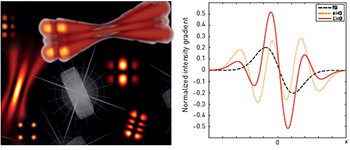 Propagation-changing Elegant Gaussian beams (left) provide enhanced gradient forces in optical manipulation as shown by the intensity gradient in the focus of the beam (right).
Propagation-changing Elegant Gaussian beams (left) provide enhanced gradient forces in optical manipulation as shown by the intensity gradient in the focus of the beam (right).
Sophisticated light fields now form a self-contained branch in photonics,1,2 where standard Gaussian (Hermite-, Laguerre- and Ince- Gaussian) as well as non-diffracting (Bessel-, Mathieu- and Airy-) beams are intensively used for laser material processing, photonic lattices or optical manipulation. To enter nanoscale dimensions, however, advanced light fields are needed that go beyond the classical approach.
The comparatively unknown class of propagation-changing Gaussian beams—so-called Elegant Gaussian beams—is almost ideally suited to that task, as additional nodal lines appearing near the focal plane uniquely change the transverse beam profile. This class of versatile beams has passed almost unrecognized since Siegman introduced them in theory in 1973,3 and until this year had not yet been implemented in experimental physics. To spotlight the versatility of Elegant Gaussian beams and make them accessible for applications in optical micro-manipulation, we recently proposed and experimentally demonstrated the holographic modulation of this class of propagation- changing Gaussian beams.4
In optical micro-manipulation, a fast-growing field in photonics with path-breaking applications in biophysics and biomedicine, focused laser beams induce attractive forces on dielectric particles and allow trapping, moving and arranging them in 3-D.5 A continuous decrease in size and simultaneous increase of the complexity of particle structures, including nanocontainers, core-shell particles, cell compartments, and other functional materials, evoke the requirement for advanced light-field shaping to particularly tailor light with respect to the size, shape, and refractive index structure of the particle.
In contrast to standard Gaussian beams, higher-order modes of Elegant Gaussian beams concentrate most of their energy close to the optical axis, due to exclusive high-angle contributions in the far field. This makes them ideally suited to create higher gradient forces at small scales and thus to resolve the actual challenges in optical manipulation.
In our work, we realized a complex holographic amplitude and phase modulation technique to generate submicron structured Elegant Gaussian beams within the focal plane of a high NA microscope objective. The analysis of the beam profiles of Elegant Hermite- and Laguerre-Gaussian modes demonstrated intensity and phase profiles in excellent agreement with theoretical predictions. Moreover, we employed z-stacks to visualize the characteristic features of propagation- changing light fields during propagation through the focal plane, before proving their potential in optical manipulation by the alignment of nanocontainer particles.4 Now that they are experimentally accessible, Elegant Gaussian beams should forge ahead and inspire manifold applications in optics and photonics.
Researchers
C. Alpmann and C. Denz, University of Münster, Münster, Germany
References
1. M. Woerdemann et al. Laser Photonics Rev. 7, 839 (2013).
2. K. Dholakia et al. Nat. Photon. 5, 335 (2011).
3. A.E. Siegman. J. Opt. Soc. Am. 63, 1093 (1973).
4. C. Alpmann et al. Appl. Phys. Lett. 106, 241102 (2015).
5. D.G. Grier. Nature 424, 810 (2003).
